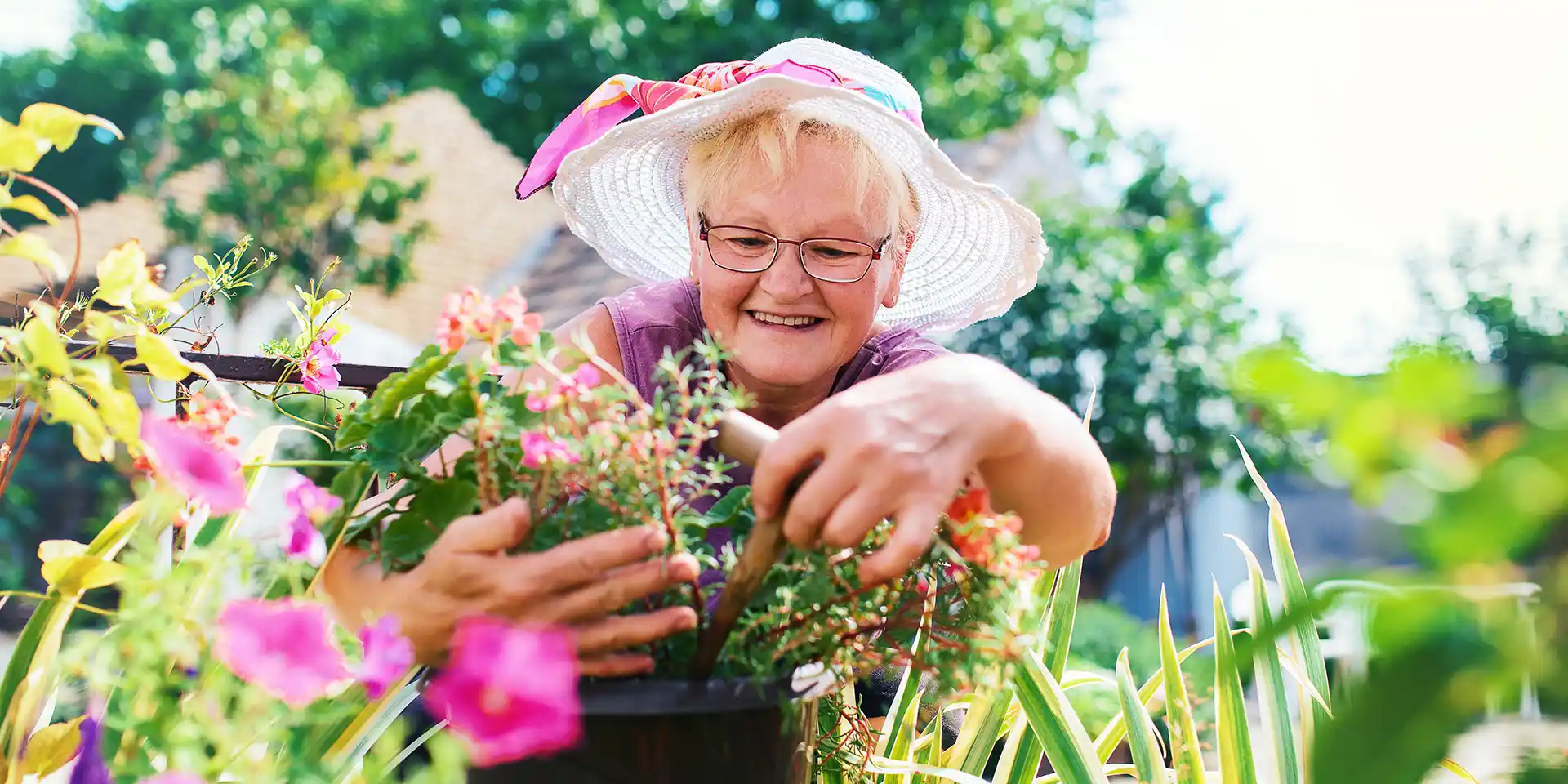Fun-filled days in the sun may be good for the soul, but a little sun goes a long way, especially for older adults. The healing power of time outdoors and soaking up some natural vitamin D are just two of the many reasons to enjoy your time with Mother Nature.
However, older adults are especially susceptible to health risks and dangers associated with the sun.
Age-related changes make it harder for your body to regulate its temperature and affect how your skin responds to the sun. Take precautions by reading up on sun safety tips for seniors before you spend too much time exposed to those potentially harmful rays. Keep reading to learn more about how the sun affects older adults and gather some practical tips for staying safe in the sun all summer long.
How the Sun Affects Seniors
In many ways, spending time outdoors is a smart move for seniors. Natural sunlight boosts your mood, delivers vitamin D to support better calcium absorption and immunity, and promotes better sleep. But, as with many things in life, too much sun can have adverse effects on your body.
Too much sun can result in skin damage, including cancer, and cause damage to your eyes. Seniors have thinner, less elastic skin, which means they have less protection from UV rays. That puts you at greater risk for skin cancer, but other potential results include painful sunburns, more pronounced wrinkles and age spots. When it comes to your eyes, too much time in the sun can put you at greater risk for serious vision-related conditions, including cataracts and macular degeneration.
Other factors affecting many seniors’ safety in the sun include medications that enhance sun sensitivity. That means you may be more likely to burn faster or experience discomfort and skin reactions when you spend too much time in the sun.
In addition, as you age, your body becomes less efficient at self-regulating your body temperature. You may not sweat as freely, which makes it harder for your body to cool itself when you get overheated. Your circulation may also be compromised, which factors into your body’s temperature regulation. When your body gets too warm and can’t cool itself, you’re at elevated risk for heat exhaustion and heat stroke, which can make you feel ill, damage organs and even result in death.
Another age-related consideration is seniors’ tendency to miss thirst cues until they’re already at or near a dehydration point. This concern is compounded by the fact that the body retains less fluid as you age, accelerating your risk of dehydration. Dehydration can wreak havoc on your bodily systems, worsening existing conditions such as kidney problems, diabetes and heart disease and introducing new symptoms like fatigue, confusion and muscle cramps.
Tips for a Senior-Friendly Summer
Although the risks of sun exposure can be serious, that doesn’t mean you have to forget your summer fun. When the sun is blazing and the risk is high, simply take extra time for precautions with these sun safety tips for seniors before heading out to enjoy your favorite senior-friendly summer activities.
Avoid the heat of the day. One of the keys to preventing heat stroke in seniors is avoiding overdoing your activity during the hottest part of the day. Typically, the heat and UV rays are most prominent from about 10 a.m. to 4 p.m. Limiting your exposure during this time will reduce your risk for skin damage, overheating and dehydration.
Always use sunscreen. Protecting your fragile, aging skin will reduce your chances of getting an uncomfortable burn or sustaining more lasting damage. Aim for a protective lotion with an SPF of at least 30. Allow 20 minutes for the lotion to absorb before you venture outdoors and reapply at least every two hours, or more often if you’re sweating heavily or swimming.
Rely on sources of relief.If you must be out in the sun, look for opportunities to take breaks in the shade or air conditioning and consider using a UV-rated umbrella. Carry a portable fan or mister to help you cool down periodically. If you’ll have access to a cooler, wet and freeze individual washcloths the night before you venture out. Fill a resealable plastic bag with the frozen cloths and store them in the cooler for a quick cool-down you can use to wipe your face, apply to your wrists or rest on the back of your neck.
Dress for the weather.Plan on loose-fitting, lightweight and light-colored outfits that give your body the freedom it needs to regulate your body temperature. Cotton and linen fabric are good choices for air circulation. Moisture-wicking material can also help protect your skin if you’re prone to sweating or skin irritation.
Stay hydrated. Many of the potential risks of sun exposure can be mitigated by staying well-hydrated. Carry extra water with you and drink regularly, even if you don’t feel thirsty. You can also add hydration by eating water-rich foods, such as watermelon, but avoid sugary drinks and alcohol, which can actually increase your risk of dehydration.
Know the signs of distress.Beyond dehydration, other serious medical conditions can arise when you spend too much time in the heat. Be vigilant in watching for signs of dizziness, fatigue and confusion, and err on the side of caution if you’re feeling unwell.
Signs of Heat-Related Illnesses in Elderly Adults
Even if you follow all of the sun safety tips for seniors, you may still find yourself unexpectedly overcome by the heat. Knowing the potential signs and symptoms of heat-related illness will allow you to recognize that you (or someone in your group) may be in danger so you can get emergency help quickly.
Two common heat-related illnesses that affect seniors are heat exhaustion and heat stroke.
Heat exhaustion is often a precursor to heat stroke. Signs of heat exhaustion include headache, nausea, dizziness, weakness, irritability, thirst, heavy sweating, elevated body temperatures and decreased urine output.
Heat stroke is a more advanced heat-related illness and involves a body temperature of 104 F or higher. A telltale sign of heat stroke, which differentiates it from heat exhaustion, is a change in mental state or behavior, such as confusion or delirium. The skin may be hot and dry (although if the condition is due to vigorous activity, the skin may be damp from sweat). Nausea, vomiting, flushed skin, rapid breathing, racing heart rate and throbbing headache are other symptoms of heat stroke that should not be ignored.
Cooling measures and hydration are essential for someone experiencing these symptoms, and particularly in the case of a suspected heat stroke, medical attention is necessary.
Getting out of the heat is the first step to safely cool down when you are experiencing heat exhaustion. Move to an air-conditioned or shady location and slowly rehydrate with a cool, non-alcoholic, caffeine-free beverage such as water or an electrolyte sports drink. Avoid the temptation to gulp the cold beverage and steer clear of icy drinks, as they can upset your stomach or cause cramps.
If you’re able to remove or loosen clothing, do so to release trapped heat. A fan and cool water can also help bring down your temperature. Promote circulation by lying down and elevating your legs.
Monitor symptoms and if you’re not seeing improvement within an hour, seek medical attention. Confusion, fainting or nausea that prevents you from taking in fluids are all signs you need more immediate care.
Enjoy an Active Summer
By taking the proper precautions and having a good understanding of the signs your health could be at risk, you’ll be ready to enjoy an active summer filled with sunshine, laughter and lots of good memories.

